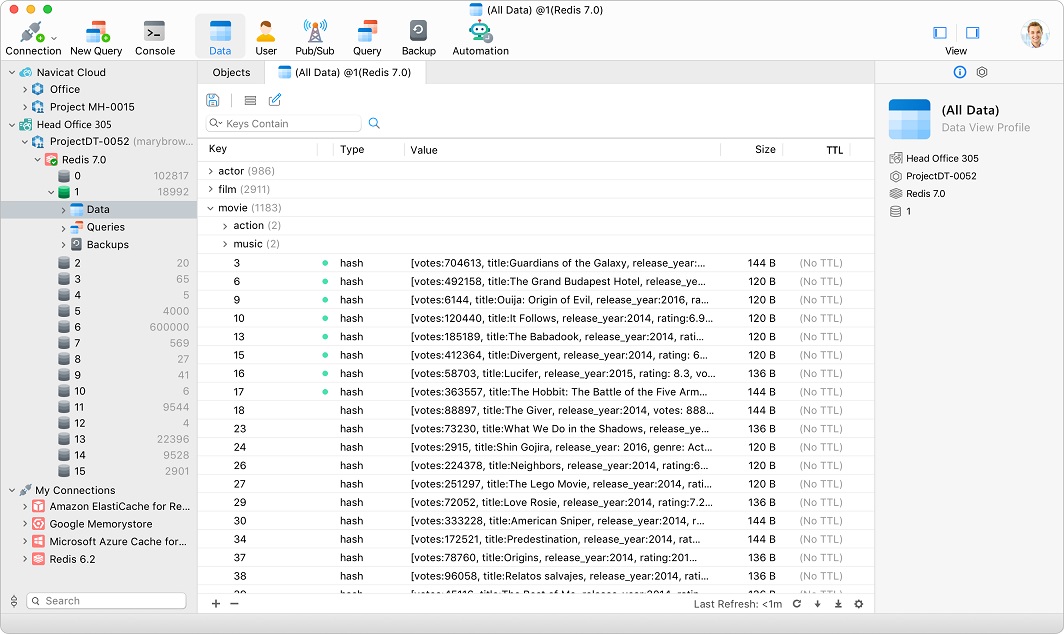Redis, short for Remote Dictionary Server, is a versatile and high-performance key-value store that has gained significant popularity in the world of databases. It is known for its exceptional speed and efficiency in handling simple data structures. In this article, we will explore what sets Redis apart from other databases and how Navicat for Redis complements it as a robust management tool.
Speed and Simplicity
Redis distinguishes itself with its remarkable speed, primarily owing to its in-memory nature. Unlike traditional databases that rely on disk storage, Redis stores data in RAM, enabling lightning-fast read and write operations. This makes Redis an ideal choice for applications that require quick data retrieval and low latency.
For example, consider a use case where a social media platform needs to retrieve user profile information. With Redis, this operation is executed almost instantaneously due to the in-memory storage, eliminating the delays associated with disk I/O operations.
Data Structures for Flexibility
One of Redis's strengths lies in its support for a wide range of data structures, each tailored for specific use cases:
- Strings: Basic key-value pairs that can store strings, integers, or floating-point numbers.
Example:SET user:1 "John Doe" - Lists: Collections of ordered elements allowing push and pop operations from both ends.
Example:LPUSH mylist "item1" - Sets: Unordered collections of unique elements, useful for tasks like counting unique items or creating tag systems.
Example:SADD tags "Redis" "Database" "NoSQL" - Hashes: Maps between string field and string values, perfect for representing objects.
Example:HSET user:1 username "johndoe" email "This email address is being protected from spambots. You need JavaScript enabled to view it."
These data structures empower developers to select the most suitable structure for their specific use case, resulting in optimized performance.
Pub/Sub Messaging
Redis offers robust support for Publish/Subscribe messaging, enabling real-time communication between different parts of an application or even between different applications. This feature is invaluable in scenarios requiring instant updates or notifications.
For example, in a gaming application, Redis Pub/Sub can be employed to notify players about in-game events, such as a new message or a player joining a room.
PUBLISH game:updates "New message: Hello, world!"
Lua Scripting for Complex Operations
Redis provides the ability to execute Lua scripts, allowing developers to perform complex operations in a single command. This is particularly useful for tasks that involve multiple steps or conditional logic.
For example, suppose you need to atomically transfer funds from one account to another while ensuring consistency. This can be accomplished with Lua scripting.
local sender_balance = tonumber(redis.call('GET', KEYS[1]))
local receiver_balance = tonumber(redis.call('GET', KEYS[2]))
local amount = tonumber(ARGV[1])
if sender_balance >= amount then
redis.call('DECRBY', KEYS[1], amount)
redis.call('INCRBY', KEYS[2], amount)
return "SUCCESS"
else
return "INSUFFICIENT FUNDS"
end
Navicat for Redis: A Comprehensive Management Tool
Navicat for Redis is a powerful GUI tool designed to enhance the management and interaction with Redis databases. It provides an intuitive interface for performing various tasks such as browsing, querying, and modifying data. Here are some key features that set Navicat for Redis apart:
- User-Friendly Interface: Navicat for Redis offers an intuitive and user-friendly interface, making it easy for both novice and experienced developers to navigate and interact with Redis databases.
- Visual Data Manipulation: With Navicat, users can easily view, edit, and manipulate data within Redis databases. This is particularly useful for tasks like updating values or adding new keys.
- Query Building: The tool allows users to construct and execute complex queries using a graphical interface. This can be a significant time-saver for developers who prefer a visual approach to querying.
- Data Import and Export: Navicat supports seamless data import and export operations, facilitating tasks such as migrating data between databases or creating backups.
- Task Automation: Navicat for Redis enables the scheduling and automation of routine tasks, helping to streamline database management processes.

Final Thoughts on What Sets Redis Apart from Other Databases
Redis stands out as a high-performance key-value store, thanks to its in-memory nature and versatile data structures. It excels in scenarios where speed and low latency are paramount. The addition of Navicat for Redis enhances the Redis experience by providing a user-friendly and efficient management tool. Navicat's features like visual data manipulation, query building, and task automation make it a valuable companion for developers working with Redis databases. Together, Redis and Navicat form a powerful combination for building robust and high-performing applications.


